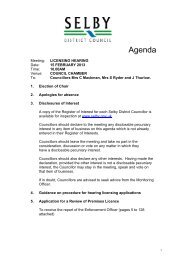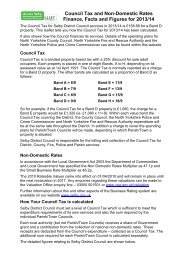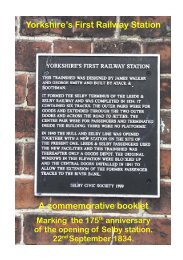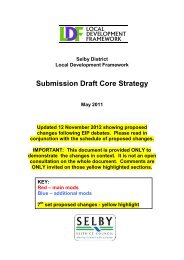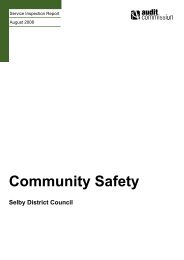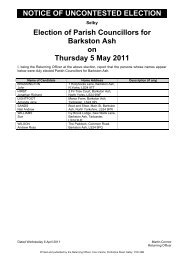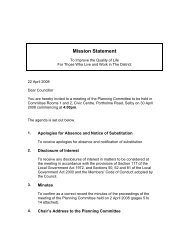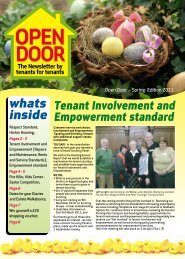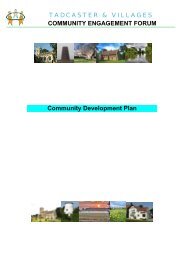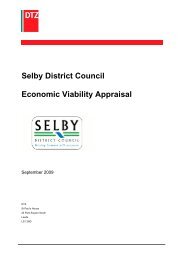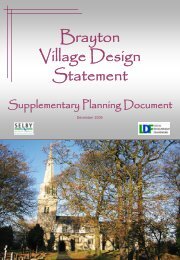Introduction - pdf 2.5Mb - Selby District Council
Introduction - pdf 2.5Mb - Selby District Council
Introduction - pdf 2.5Mb - Selby District Council
You also want an ePaper? Increase the reach of your titles
YUMPU automatically turns print PDFs into web optimized ePapers that Google loves.
<strong>Selby</strong> <strong>District</strong> Renaissance<br />
STRATEGIC DEVELOPMENT FRAMEWORK
Yorkshire Forward:<br />
Victoria House 2 Victoria Place Leeds, LS11 5AE<br />
0113 394 9600 - www.yorkshire-forward.com<br />
<strong>Selby</strong> <strong>District</strong> <strong>Council</strong>:<br />
Civic Centre Portholme Road <strong>Selby</strong> YO8 4SB<br />
01757 705101 - www.selby.gov.uk<br />
Consultants Team led by URBED:<br />
10 Little Lever Street Manchester M1 1HR<br />
0161 200 5500 - www.urbed.com<br />
also 19 Store Street, London, WC1E 7DH
<strong>Selby</strong> <strong>District</strong> Renaissance<br />
STRATEGIC DEVELOPMENT FRAMEWORK
The launch of the <strong>Selby</strong> <strong>District</strong> Charter September 2005<br />
The town teams<br />
Town teams representing each of the three towns have now been meeting<br />
for more than a year working first on the <strong>Selby</strong> <strong>District</strong> Charter and on this<br />
Strategic Development Framework. Over the years scores of people have been<br />
involved in the teams.<br />
The renaissance team<br />
This Strategic Development Framework together with the<br />
<strong>District</strong> Charter has been produced for the Town Teams by<br />
a consultancy team commissioned by Yorkshire Forward<br />
working in partnership with <strong>Selby</strong> <strong>District</strong> <strong>Council</strong>. The renaissance<br />
team has included the following people:<br />
Yorkshire Forward: Barra Mac Ruairí, Dr. Jemma Basham,<br />
John Shepherd<br />
<strong>Selby</strong> <strong>District</strong> <strong>Council</strong>: Eileen Scothern, Terry Heselton,<br />
Neil Skinner, Peter Brown<br />
<strong>Selby</strong> Town Team Sherburn Town Team Tadcaster Town Team<br />
URBED: David Rudlin, Stephanie Fischer, Nick Dodd,<br />
Dr Nicholas Falk, Sarah Jarvis, Helene Rudlin, Debbie Fuller,<br />
Zoe Holden, Matthew Ludlam, Lorenza Casini, Vassiliki<br />
Kravva and David Suls<br />
URBED’s local representative in <strong>Selby</strong> - Blue Wilson<br />
Alan Baxter & Associates: Robert Green, David Taylor,<br />
Sophie Noble<br />
Camlin Lonsdale: Jessica Bryne-Daniel, Victoria Berryman<br />
Tomlinson Feeley: Michelle Tomlinson<br />
Town Team chairs:<br />
Sherburn: Peter Lambert<br />
Tadcaster: Sir Bryan Askew<br />
<strong>Selby</strong>: Michael Dyson (previously Alan Townend)<br />
Our proposals within the SDF will need to be compliant<br />
with national, regional and local planning strategies and<br />
policies. It is accepted that the proposals contained within<br />
this document may not meet these at the present time<br />
given this document’s status as a 25-year vision statement.
Foreword<br />
The <strong>Selby</strong> <strong>District</strong> Charter was<br />
launched in September last year.<br />
The launch culminated in an excellent<br />
event in <strong>Selby</strong> Abbey where there<br />
was a real sense of excitement in the<br />
shared vision set out in the Charter.<br />
This vision has been carried forward<br />
in this document, which provides<br />
much more detail and sets out a<br />
range of realistic projects that we can<br />
all work to implement.<br />
I would, once again, like to thank all<br />
of the people who have contributed<br />
to this piece of work. It is more than<br />
just a consultant’s report, it is a vision<br />
generated collectively by the people<br />
of the <strong>Selby</strong> <strong>District</strong>. We may not all<br />
agree with everything in these pages,<br />
but we can, I believe, sign up to the<br />
exciting vision and agenda for change<br />
that it sets out. I look forward to working<br />
with the town teams and all the<br />
stakeholders involved in this process<br />
to make it a reality.<br />
Mark Crane<br />
Leader, <strong>Selby</strong> <strong>District</strong> <strong>Council</strong><br />
Yorkshire Forward believes that the towns and cities of Yorkshire<br />
are the key to its future. We further believe that the key to<br />
the future success of the region’s towns and cities lies with the<br />
communities and businesses that live and work in them.<br />
The Yorkshire Forward Renaissance programme has developed<br />
Charters for 19 of Yorkshire’s towns and cities. In each case we have<br />
worked with a Town Team set up, initially to guide the work on the<br />
Charter, and subsequently as a focus for implementation of the<br />
25-year vision that the Charter sets out.<br />
An important step on the route to the implementation of the Charter<br />
is the Strategic Development Framework (SDF) such as this<br />
document for the <strong>Selby</strong> <strong>District</strong>. This SDF sets out more detail of the<br />
projects required to implement the renaissance vision. This document<br />
does this through sections on three of the most important<br />
themes in the <strong>Selby</strong> <strong>District</strong> Charter; the future of Energy, Water and<br />
Business and also includes masterplans for each of the three towns.<br />
The masterplans develop the core aim of the Yorkshire Forward<br />
programme to harness the power of place by tapping into the<br />
passion and enthusiasm of local people. The projects set out in<br />
this document include the creative use of architecture, urban design<br />
and landscaping to transform the quality of the public realm<br />
of the district, the streets, parks and public spaces of the towns.<br />
This is achieved partly through public realm works - a theme that<br />
runs through all of the renaissance towns. However, the SDF is also<br />
about the future growth of the three towns and where new housing<br />
should be planned. It is also about the future economy of the district<br />
and how, following the closure of the mines, changes in the energy<br />
industry can be harnessed as an engine for sustainable growth.<br />
The process of creating this SDF has been creative, collaborative<br />
and argumentative, we would expect nothing less. I hope and<br />
believe that the investment of time and effort that everyone made<br />
over the last twelve months will now start to generate a return as we<br />
work together to implement the projects in this document.<br />
Barra Mac Ruairí<br />
Head of Renaissance Towns & Cities<br />
Yorkshire Forward
Contents<br />
Foreword 5<br />
<strong>Introduction</strong> 8<br />
Regional Renaissance 8<br />
The district today 10<br />
A 25-year vision 12<br />
Tadcaster<br />
<br />
Sherburn<br />
<br />
<strong>Selby</strong><br />
8<br />
Part 1: Water 20<br />
A district shaped by water 22<br />
Human influences 24<br />
The threat 26<br />
The concept 28<br />
The masterplan 30<br />
Flood defence 32<br />
Yorkshire Water Park 34<br />
Tidal barrage<br />
8<br />
Part 2: Economy 40<br />
The district’s history 42<br />
The strategy 44<br />
Soil; the new oil 46<br />
The plan<br />
8<br />
A ladder of innovation 50<br />
<strong>Selby</strong> <strong>District</strong> Science Park 52<br />
Gascoigne Wood Biopole Centre 54<br />
Training and skills 56<br />
Part 3: Energy 58<br />
Context 60<br />
Timeline 62<br />
Energy Renaissance 64<br />
Home Comfort 68<br />
Growing Opportunities<br />
0<br />
Community Heating<br />
<br />
Future Coal<br />
8<br />
Developing Eco-industries 82<br />
Part 4: Tadcaster 84<br />
Tadcaster masterplan 86<br />
History of Tadcaster 88<br />
The town today 90<br />
The concept 94<br />
The plan 96<br />
Livable Streets: High Street 98<br />
Quality environments: Car Park and Kirkgate 102<br />
Quality environments: The Valley<br />
06<br />
Smart Growth: Mill Lane<br />
08<br />
Part 5: Sherburn 110<br />
Sherburn masterplan<br />
<br />
History of Sherburn<br />
<br />
The town today<br />
<br />
The concept<br />
8<br />
The plan<br />
0<br />
Livable Streets: Low Street<br />
<br />
Quality Environments: Village Square<br />
<br />
Smart Growth: Sissons’ Depot<br />
8<br />
Smart Growth: Gascoigne Wood<br />
0<br />
Smart Growth: Eco-Village<br />
<br />
Quality Environments: Country Park<br />
<br />
Part 6: <strong>Selby</strong> 138<br />
<strong>Selby</strong> masterplan<br />
0<br />
History of <strong>Selby</strong><br />
<br />
Town centre health check<br />
<br />
The town today<br />
8<br />
The concept<br />
52<br />
The plan<br />
54<br />
Revitalising the town centre<br />
56<br />
Living Streets: Gowthorpe to New Street 158<br />
Quality Environments: Waterfront Park 162<br />
Smart Growth: Station Quarter<br />
<br />
Smart Growth: Holme Lane<br />
0
introduction
<strong>Selby</strong> <strong>District</strong> sits at the heart<br />
of the Yorkshire and the Humber<br />
region. Situated midway<br />
between the great cities of Leeds,<br />
York, Hull and Sheffield, it has a central<br />
role to play in the future prosperity<br />
and quality of life of the region.<br />
Yorkshire and the Humber has<br />
a GDP of £71 Billion. If it were a<br />
country this would rank it in the top<br />
third of the world’s national economies.<br />
It is home to five of the world’s<br />
top ten companies and the regional<br />
economy is growing faster than the<br />
European average. Manufacturing is<br />
predicted to grow by more than 12%<br />
over the next 10 years, the region<br />
has one of the fastest growing IT<br />
sectors in the UK and the largest<br />
concentration of food research and<br />
production.<br />
This economic success is<br />
closely linked to the quality of life<br />
in the region. This is based on everything<br />
from the bright lights of the big<br />
cities, the charm and character of<br />
the regions smaller towns and the<br />
tranquillity of the countryside and the<br />
three national parks on the region’s<br />
doorstep.<br />
The future success of the region<br />
will depend not on its industries or<br />
its natural resources but its people.<br />
The regions that will prosper in the<br />
future will be those that produce<br />
and retain highly skilled people.<br />
This brings together the economy,<br />
educational institutions and quality of<br />
life and is the essence of the renaissance<br />
programme.<br />
The major cities may be the engine<br />
of the region’s growth, a strategy<br />
reinforced by the Government’s<br />
Northern Way policy, however,<br />
the cities are nothing without their<br />
hinterland and without the network of<br />
industrial and market towns across<br />
the region.<br />
Places like the <strong>Selby</strong> <strong>District</strong>, its<br />
towns and its countryside contribute<br />
significantly to the quality of life of<br />
the region. The district provides<br />
excellent places to live, work and<br />
visit and contributes hugely to the<br />
appeal of the region. It is also vital<br />
economically, accommodating modern<br />
manufacturing and distribution,<br />
energy production and food production.<br />
The <strong>Selby</strong> <strong>District</strong> Charter and<br />
this SDF are therefore designed to<br />
secure the renaissance of the towns<br />
of the <strong>Selby</strong> <strong>District</strong> as part of the<br />
renaissance of the region.
10<br />
Work on the <strong>Selby</strong> <strong>District</strong><br />
Charter has included<br />
detailed studies of the district,<br />
its people, economy, environment<br />
and transport links. This work<br />
is summarised in the Charter.<br />
The district is home to almost<br />
76,500 people, which is just 1.6%<br />
of the population of the region. It is a<br />
relatively sparsely populated district<br />
and just over half of these people<br />
live in the towns, which occupy just<br />
2.6% of the land area.<br />
<strong>Selby</strong> is the largest town although<br />
its population is just 13,000<br />
people (22,500 if the adjoining<br />
wards of Barlby and Brayton are<br />
included). This still means that it<br />
has half of the population of nearby<br />
towns such as Pontefract or Castleford.<br />
Sherburn and Tadcaster are a<br />
good deal smaller with populations<br />
of around 6,000.<br />
The district is strongly influenced<br />
by the surrounding cities. Sherburn<br />
relates to Leeds and has become an<br />
important commuting centre. This<br />
has tended to increase house prices<br />
beyond the reach of many of the<br />
people who work in the major local<br />
industries who therefore have to<br />
commute into the area.<br />
In a similar way Tadcaster<br />
relates to York, although its role as<br />
a commuter centre has been limited<br />
by its lack of railway station and the<br />
low level of house building in recent<br />
years. This has pushed up houseprices<br />
to some of the highest in the<br />
district. The town is dominated by<br />
its breweries and again, many of the<br />
brewery workers have to commute<br />
into the town.<br />
The town of <strong>Selby</strong> is in a slightly<br />
different position. Its relative isolation<br />
means that it is not a major<br />
commuting centre. This also means<br />
that it attracts shoppers who do not<br />
wish to face the trek into Leeds or<br />
York, allowing it to sustain a larger<br />
town centre than one might expect<br />
for a town of its size.<br />
The population of the district is<br />
ageing but relatively affluent. The<br />
rate of employment (83%) is high<br />
and 10% of the population have<br />
degrees. <strong>Selby</strong> Town is the exception<br />
to this and in 2004 one ward was<br />
within the 20% most deprived nationally<br />
(although this had improved<br />
on the three wards in this position in<br />
2000). The level of qualifications in<br />
<strong>Selby</strong> is also nearly half the average<br />
for the district.<br />
The prosperity of the district<br />
and the overspill from the growth of<br />
Leeds and York has led to pressure<br />
for housing development in the district.<br />
There has been intense debate<br />
about where to accommodate this<br />
housing. This, however, is likely to<br />
ease as the Regional Spatial Strategy<br />
directs housing growth into the<br />
larger cities.<br />
This picture of prosperity<br />
initially seems to be at odds with<br />
the district’s recent history, which<br />
saw the closure in 2004 of the UK’s<br />
largest and most modern mining<br />
complex that employed 2,000 people<br />
and supported another 2,000 jobs.<br />
<strong>Selby</strong> has survived this blow partly<br />
because many miners transferred to<br />
<strong>Selby</strong> following the closure of mines<br />
introduction
in surrounding districts where they<br />
continued to live. It is also the case<br />
that many miners have retrained and<br />
found work that is plentiful in the<br />
distribution sector in <strong>Selby</strong>. The mine<br />
in <strong>Selby</strong> was not opened until 1983<br />
and was open for just over 20 years.<br />
The towns of <strong>Selby</strong> are not therefore<br />
mining towns but market towns that<br />
happen to be near a mine.<br />
Much more important are the<br />
two power stations in the district;<br />
Eggborough and Drax (and Ferrybridge<br />
just over the boundary). Together<br />
these account for 10% of the<br />
UK’s generating capacity. The mine<br />
that supplied these stations with coal<br />
has gone; they have been sold off<br />
into different ownerships and they<br />
face pressures to reduce CO 2<br />
emissions<br />
so that their future is not as<br />
secure as it once seemed. The future<br />
of energy production is therefore a<br />
major theme for the Charter and is<br />
dealt with in Section 2 of this SDF.<br />
Elsewhere the economy of the<br />
district has responded well to the<br />
changing economic climate. <strong>Selby</strong><br />
has lost its port and ship building<br />
function but has seen a growth in<br />
food processing and a significant<br />
expansion of distribution. The breweries<br />
of Tadcaster have prospered<br />
although staffing has been reduced<br />
through productivity improvements.<br />
Major expansion is also taking place<br />
at the Sherburn Industrial Estate.<br />
The renaissance of <strong>Selby</strong> <strong>District</strong><br />
is therefore not about the urban<br />
regeneration of a declining area.<br />
The area’s economy is strong, it is<br />
a popular place to live and provides<br />
and excellent quality of life. The<br />
challenge is to build upon these<br />
strengths to secure the districts<br />
prosperity and to address the<br />
weaknesses that do exist,<br />
particularly in the three town<br />
centres.<br />
11
12<br />
The <strong>Selby</strong> <strong>District</strong> Charter<br />
We, the communities and stakeholders of Tadcaster, Sherburn-in-Elmet and <strong>Selby</strong>, commit<br />
ourselves to the physical, social and economic renaissance of the towns so that...<br />
they become good places to live with a range of high-quality affordable housing. We will encourage<br />
population growth by accommodating new housing in the most sustainable locations so that it supports<br />
town centres and creates attractive sustainable communities.<br />
they are focused on thriving town centres, with bustling shops, high quality services and attractive<br />
environments serving the people of the towns and visitors.<br />
they make the most of their rich heritage and history as a source of identity and pride, as a way of<br />
projecting a positive image and as a magnet for visitors.<br />
they are able to look to the future by building on their current industries while diversifying their economies<br />
through a range of high-tech, knowledge and eco-industries.<br />
they embrace the change in the energy industry following the closure of the mines and promote energy<br />
efficiency and renewable forms of heat and power generation.<br />
they work creatively to manage the water that dominates the district to control flooding, to improve<br />
the appearance and navigability of the river and increase the attractions of the area to visitors and<br />
wildlife.<br />
introduction
1. Growing smart<br />
3. Uncovering hidden<br />
heritage<br />
5. Embracing energy<br />
futures<br />
13<br />
2. Revitalising town<br />
centres<br />
4. Diversifying the<br />
economy<br />
6. Managing water<br />
These six themes are not designed to transform<br />
<strong>Selby</strong> <strong>District</strong> in the short term. The district does<br />
not need such radical transformation unlike<br />
some of the towns hardest hit by mine closures.<br />
Rather the Charter looks to the medium<br />
and longer term over the next 25 years. If the<br />
district and its towns are to be successful over<br />
the next quarter century it needs to know where<br />
it wants to be (As set out in the Charter) and to<br />
have a plan in place to get there (this SDF).<br />
The <strong>Selby</strong> <strong>District</strong> Charter<br />
published in September 2005<br />
addressed the challenges described<br />
in the previous section. This<br />
was based, in part on incorporating<br />
the <strong>Selby</strong> <strong>District</strong> into the ‘Golden<br />
Triangle’ of prosperity that exists<br />
between Leeds, York and Harrogate.<br />
The vision sees the <strong>Selby</strong> <strong>District</strong><br />
benefiting from, and contributing to,<br />
the prosperity of the region by accommodating<br />
population growth and<br />
economic development in a way that<br />
strengthens the district. Put another<br />
way the challenge in the district is not<br />
to generate demand for development<br />
but to take of advantage of existing<br />
growth pressures by seeing them as<br />
an opportunity rather than a threat. In<br />
the Charter this vision is developed<br />
into six themes:<br />
Smart Growth: A smart growth<br />
strategy harnesses growth to create<br />
positive benefits for towns, their<br />
economy and the environment. In the<br />
past growth has often been seen as<br />
a threat, building on the countryside,<br />
generating traffic and creating dormitory<br />
estates of people who do not<br />
integrate into the community. Smart<br />
Growth turns this around by directing<br />
housing development into the heart<br />
of town where it can use poor quality<br />
land, be served by public transport<br />
and be within walking distance of<br />
shops and facilities so providing them<br />
with new customers.<br />
In <strong>Selby</strong> and Tadcaster this<br />
strategy means that the masterplans<br />
direct new housing to the heart of the<br />
towns. In Sherburn the lack of opportunities<br />
in the heart of the town lead<br />
us to propose that housing growth is<br />
accommodated in a new Eco-Village<br />
at Gascoigne Wood.<br />
Strengthening town centres: The<br />
three towns of <strong>Selby</strong> <strong>District</strong> have<br />
historic roots, strong identities and<br />
loyal local communities. All of these<br />
factors focus on their town centres.<br />
The towns are very different, however<br />
each is struggling to maintain the<br />
traditional character of its town centre<br />
in the face of competition from other<br />
towns and out-of-town development.<br />
The second theme therefore relates to<br />
the strengthening of the town centres<br />
as described in the three masterplans.<br />
Uncovering hidden heritage: <strong>Selby</strong><br />
<strong>District</strong> has an extraordinary diverse<br />
history, from Roman Tadcaster to<br />
Saxon Sherburn and Norman <strong>Selby</strong>.<br />
It also stands just a few miles from<br />
York, the most visited historic city in<br />
England. Because of this, its heritage<br />
has been somewhat overlooked. The<br />
third theme is therefore to uncover<br />
this heritage as a focus for local pride<br />
and identity and a draw for visitors as<br />
covered in the three masterplans.<br />
Diversifying the Economy: The<br />
Charter Vision is based on economic<br />
growth as much as environmental<br />
improvements and housing development.<br />
The Economic topic masterplan<br />
in Section 2 of this SDF therefore sets<br />
out a strategy for further developing<br />
the economic strengths of the district.<br />
It includes training, skills, and the<br />
capacity of the workforce, support<br />
for existing business sectors such as<br />
manufacturing and distribution and<br />
diversification into knowledge sectors<br />
based on spin-offs from York Science<br />
Park.<br />
Embracing energy futures: Energy<br />
production is vital to the economy of<br />
the district. Now that the mines are<br />
gone and with increasing pressures<br />
to reduce the emissions from the coal<br />
fired power stations, <strong>Selby</strong> needs to<br />
reinvent its energy sector. If it does<br />
not do this international agreements<br />
to limit global warming will eventually<br />
see the closure of the power stations.<br />
However if action is taken now <strong>Selby</strong><br />
can get ahead of the game and reap<br />
potentially huge rewards from low<br />
carbon energy production.<br />
Managing Water: The final theme in<br />
the Charter (and the first that we deal<br />
with in this SDF) relates to the force<br />
that has shaped the district over the<br />
last thousand years - the rivers and<br />
their flood plains. Flooding will increase<br />
as a threat as global warming<br />
increases. Flood defences are necessary<br />
but will be expensive and could<br />
have a negative effect on the towns.<br />
Now is the time to explore more<br />
radical solutions to reduce flooding<br />
and use the water that dominates the<br />
district and a resource for leisure and<br />
wildlife.<br />
The Charter also included visions<br />
for each of the three towns as<br />
described on the following pages:
14<br />
ntroduction<br />
Vision<br />
‘A historic brewing town with an unspoilt character that is a good place to live and<br />
visit.’<br />
Proposals<br />
Living Streets<br />
Phase 1:<br />
1. High Street improvements<br />
2. Implementation of traffic management strategy<br />
3. Signing strategy for bypass<br />
Phase 2:<br />
4. Junction improvements on the bypass to remove through traffic<br />
Quality environments<br />
Phase 1:<br />
5. Improvements to central car park<br />
6. Robin Hood Yard improvements<br />
Phase 2:<br />
7. Flood alleviation strategy<br />
8. Riverside landscaping and circular walk<br />
Smart Growth<br />
Phase 1:<br />
9. Reusing existing buildings<br />
10. Infill development<br />
11. Living over the shop<br />
Phase 2:<br />
12. Sheltered housing on the Powerplus site<br />
13. Development of Mill Lane for riverside housing<br />
Tadcaster
Tadcaster<br />
4<br />
15<br />
8<br />
7<br />
2<br />
13<br />
6<br />
12<br />
1<br />
3<br />
5
16<br />
Vision<br />
‘A large village with a strong community focused on a lively high<br />
street. This will be at the centre of a network of villages including a<br />
new Eco-Village on Gascoigne Wood.’<br />
Proposals<br />
Living Streets<br />
1. Improvements and calming of Low Street<br />
2. Calming of traffic at the cross roads of Low Street / Finkle Hill<br />
with Kirkgate / Moor Lane<br />
3. Improved links by bus, cycle and foot to Sherburn Industrial<br />
Estate<br />
4. A gateway next to Eversley Park linked to the development of Sissons’<br />
Depot<br />
Quality Environments<br />
5. The recreation of the village square between the Social Club and<br />
Kirkgate<br />
6. Improvements to the frontage of the Social Club together with<br />
infill development fronting the square<br />
7. Improvements to Eversley Park with a new link to Low Street<br />
8. The development of a Country Park on the former Gascoigne<br />
Wood spoil heaps<br />
Smart Growth<br />
9. End to greenfield housing in Sherburn<br />
10. Small developments around the village square<br />
11. Relocation of Sissons’ depot to site on the bypass and sheltered<br />
housing or live/work scheme<br />
12. The development of an Eco-Village linked to a Techno-pole and<br />
Country Park on the Gascoigne Wood mine site<br />
2<br />
10<br />
5<br />
6<br />
7<br />
1<br />
4<br />
11<br />
herburn<br />
introduction<br />
5
Sherburn<br />
17<br />
8<br />
12<br />
3<br />
11<br />
9
18<br />
Vision<br />
‘<strong>Selby</strong> will become a 21st century market town with a lively town centre surrounded<br />
by high quality urban housing and diverse thriving businesses.’<br />
Proposals<br />
Living Streets<br />
Phase 1:<br />
1. Calming and environmental improvements to Gowthorpe<br />
2. Improvements to Market Place<br />
3. Calming of New Street with a weight limit<br />
Quality Environments<br />
Phase 1:<br />
4. Creation of a Riverside Park<br />
5. Improvements to <strong>Selby</strong> Park<br />
Phase 2:<br />
6. Landmark footbridge<br />
7. Regional water park<br />
Smart Growth<br />
Phase 1:<br />
8. Development of the Travis Perkins site for flats with ground floor uses including<br />
incubator workspace for science park<br />
9. Renaissance centre: including tourist information centre, town centre management<br />
and base for the Renaissance Officer<br />
10. Development of the Holmes Lane site for housing<br />
11. Development of the first part of the Olympia Park site including residential,<br />
retail and industrial uses<br />
12. Industrial development on <strong>Selby</strong> bypass<br />
13. Acquisition and conversion of Abbots Staithes for studio space, <strong>Selby</strong> Museum<br />
and Abbey facilities<br />
14. Acquisition and restoration of the old railway station<br />
Alternative site for the Science Park on <strong>Selby</strong> bypass<br />
Phase 2:<br />
15. Development of the Station Quarter either as mixed-use neighbourhood or an<br />
alternative site for the Science Park<br />
16. Development of the science park on the bypass<br />
17. Marina development linked to the water park<br />
18. Redevelopment of the bus station<br />
1<br />
introduction<br />
6<br />
<strong>Selby</strong>
<strong>Selby</strong><br />
19<br />
7<br />
10<br />
14<br />
3<br />
2<br />
13<br />
4<br />
5<br />
9<br />
8<br />
14<br />
6<br />
11<br />
16<br />
12<br />
15<br />
18



